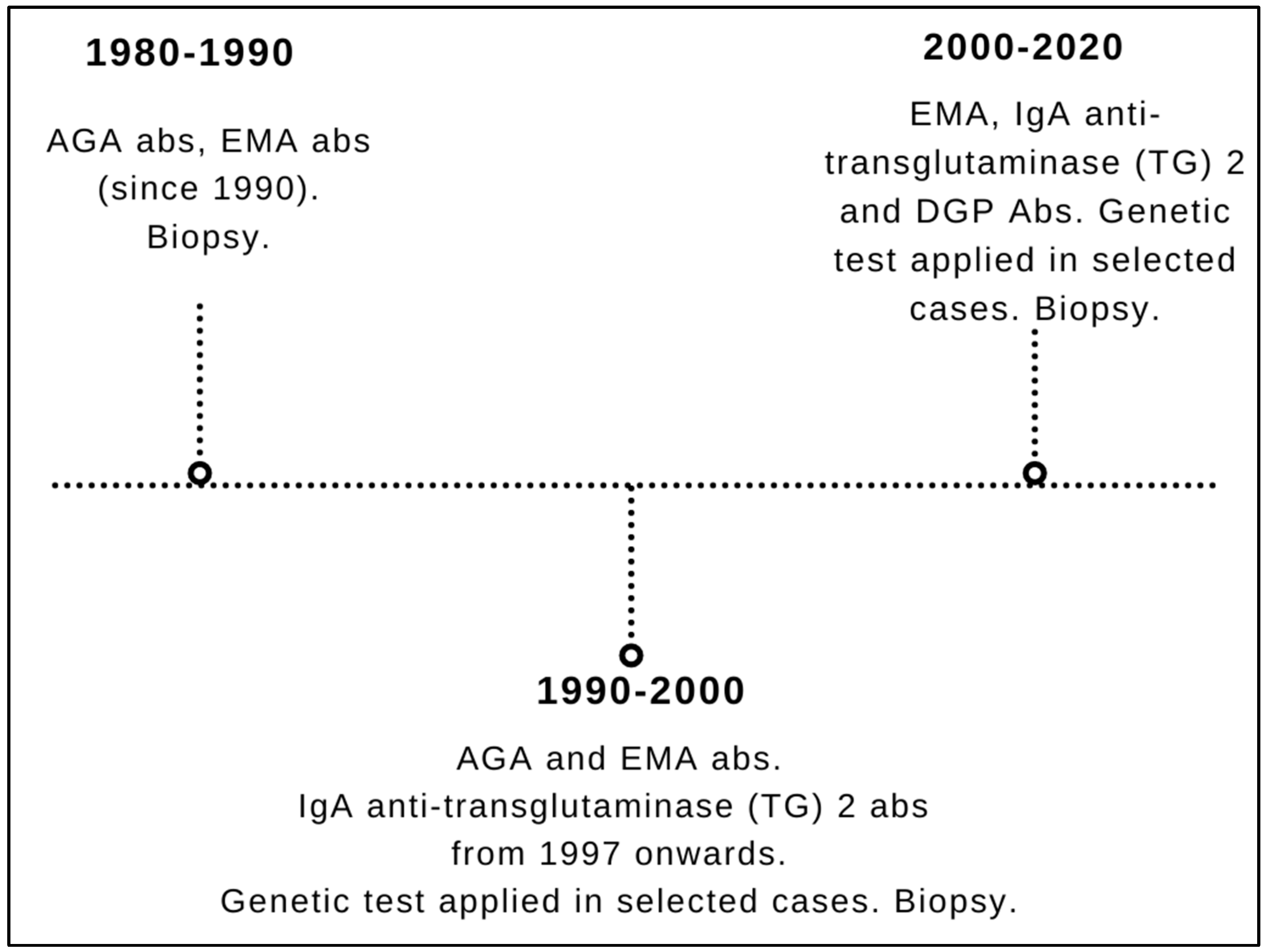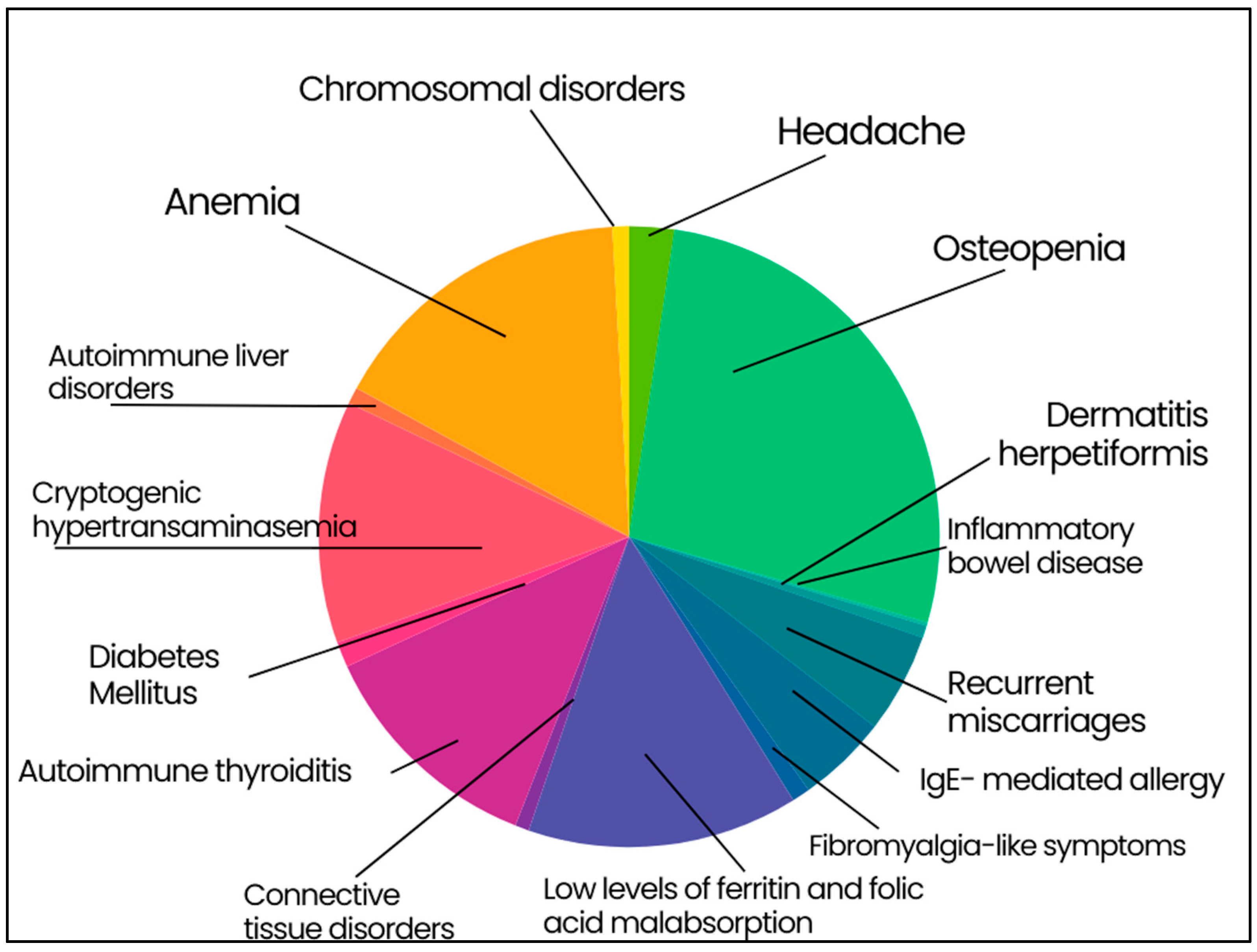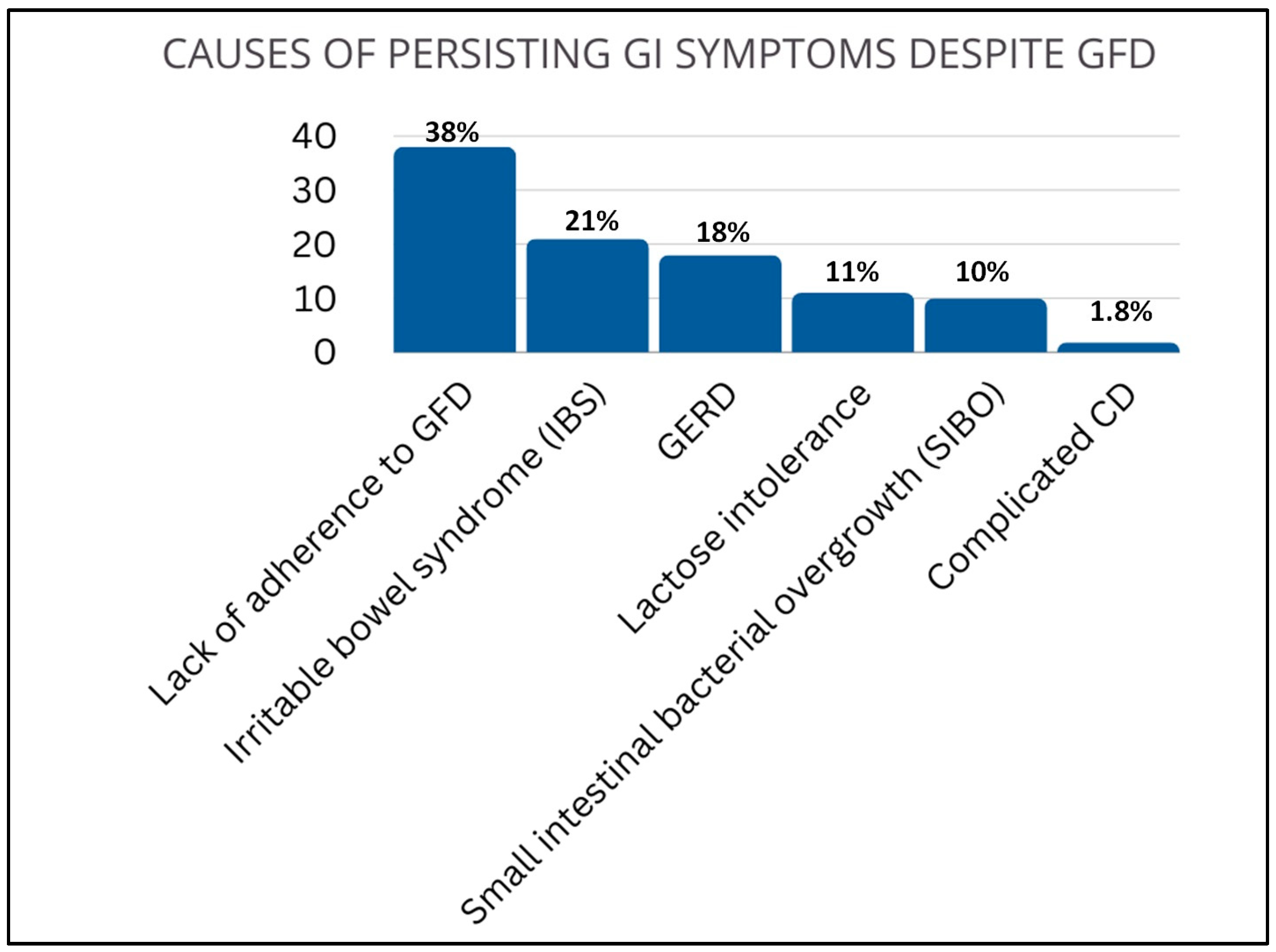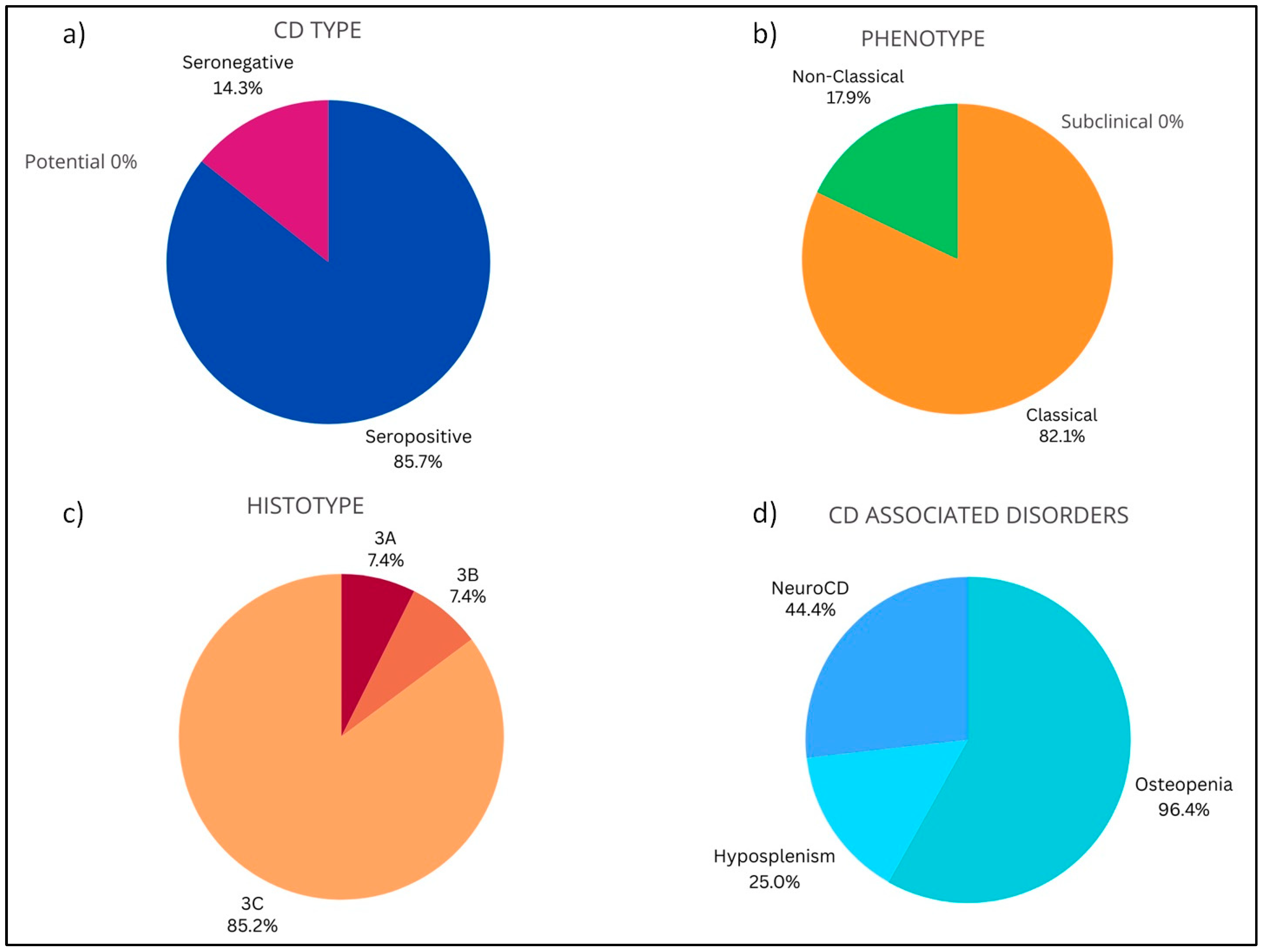Celiac Disease: A Forty-Year Analysis in an Italian Referral Center
Abstract
1. Introduction
2. Materials and Methods
Statistical Analysis
3. Results
3.1. Clinical Data
3.2. Analysis by Sex
3.3. Analysis by CD Type
3.4. Analysis by Phenotype
3.5. Serological Tests
3.6. Extraintestinal Manifestations
3.7. Gastrointestinal Symptoms in Patients on GFD
3.8. Complications
3.9. Mortality
4. Discussion
5. Conclusions
Author Contributions
Funding
Institutional Review Board Statement
Informed Consent Statement
Data Availability Statement
Conflicts of Interest
Abbreviations
| CD | Celiac Disease |
| HLA | Human leukocyte antigen |
| DGP | Deamidated gliadin peptide |
| IgA | Immunoglobulin A |
| TG | Transglutaminase |
| EmA | Anti-endomysium; |
| GFD | Gluten-free diet |
| DH | Dermatitis herpetiformis |
| OR | Odds ratio |
| CI | Confidence Interval |
| GERD | Gastroesophageal reflux disease |
| neuroCD | Neurological disorders associated with CD |
| AGA | Anti-gliadin antibodies. |
References
- Caio, G.; Volta, U.; Sapone, A.; Leffler, D.A.; De Giorgio, R.; Catassi, C.; Fasano, A. Celiac disease: A comprehensive current review. BMC Med. 2019, 17, 142. [Google Scholar] [CrossRef] [PubMed]
- Ludvigsson, J.F.; Leffler, D.A.; Bai, J.C.; Biagi, F.; Fasano, A.; Green, P.H.R.; Hadjivassiliou, M.; Kaukinen, K.; Kelly, C.P.; Leonard, J.N.; et al. The Oslo definitions for coeliac disease and related terms. Gut 2013, 62, 43–52. [Google Scholar] [CrossRef] [PubMed]
- Ivarsson, A.; Hernell, O.; Stenlund, H.; Persson, L.A. Breast-feeding protects against celiac disease. Am. J. Clin. Nutr. 2002, 75, 914–921. [Google Scholar] [CrossRef]
- Norris, J.M.; Barriga, K.; Hoffenberg, E.J.; Taki, I.; Miao, D.; Haas, J.E.; Emery, L.M.; Sokol, R.J.; Erlich, H.A.; Eisenbarth, G.S.; et al. Risk of celiac disease autoimmunity and timing of gluten introduction in the diet of infants at increased risk of disease. JAMA 2005, 293, 2343–2351. [Google Scholar] [CrossRef]
- Ludvigsson, J.F.; Fasano, A. Timing of introduction of gluten and celiac disease risk. Ann. Nutr. Metab. 2012, 60, 22–29. [Google Scholar] [CrossRef]
- Skoracka, K.; Hryhorowicz, S.; Rychter, A.M.; Ratajczak, A.E.; Szymczak-Tomczak, A.; Zawada, A.; Słomski, R.; Dobrowolska, A.; Krela-Kaźmierczak, I. Why are western diet and western lifestyle pro-inflammatory risk factors of celiac disease? Front. Nutr. 2022, 9, 1054089. [Google Scholar] [CrossRef]
- Volta, U.; Caio, G.; Stanghellini, V.; De Giorgio, R. The changing clinical profile of celiac disease: A 15-year experience (1998-2012) in an Italian referral center. BMC Gastroenterol. 2014, 14, 194. [Google Scholar] [CrossRef]
- Dieterich, W.; Laag, E.; Schöpper, H.; Volta, U.; Ferguson, A.; Gillett, H.; Riecken, E.O.; Schuppan, D. Autoantibodies to tissue transglutaminase as predictors of celiac disease. Gastroenterology 1998, 115, 1317–1321. [Google Scholar] [CrossRef]
- Villalta, D.; Tonutti, E.; Prause, C.; Koletzko, S.; Uhlig, H.H.; Vermeersch, P.; Bossuyt, X.; Stern, M.; Laass, M.W.; Ellis, J.H.; et al. IgG antibodies against deamidated gliadin peptides for diagnosis of celiac disease in patients with IgA deficiency. Clin. Chem. 2010, 56, 464–468. [Google Scholar] [CrossRef] [PubMed]
- Oberhuber, G.; Granditsch, G.; Vogelsang, H. The histopathology of coeliac disease: Time for a standardized report scheme for pathologists. Eur. J. Gastroenterol. Hepatol. 1999, 11, 1185–1194. [Google Scholar] [CrossRef]
- Biagi, F.; Gobbi, P.; Marchese, A.; Borsotti, E.; Zingone, F.; Ciacci, C.; Volta, U.; Caio, G.; Carroccio, A.; Ambrosiano, G.; et al. Low incidence but poor prognosis of complicated coeliac disease: A retrospective multicentre study. Dig. Liver Dis. 2014, 46, 227–230. [Google Scholar] [CrossRef] [PubMed]
- Di Sabatino, A.; Brunetti, L.; Maffè, G.C.; Giuffrida, P.; Corazza, G.R. Is it worth investigating splenic function in patients with celiac disease? World J. Gastroenterol. 2013, 19, 2313–2318. [Google Scholar] [CrossRef] [PubMed]
- Volta, U.; Caio, G.; Giancola, F.; Rhoden, K.J.; Ruggeri, E.; Boschetti, E.; Stanghellini, V.; De Giorgio, R. Features and Progression of Potential Celiac Disease in Adults. Clin. Gastroenterol. Hepatol. 2016, 14, 686–693.e1. [Google Scholar] [CrossRef] [PubMed]
- Catassi, C.; Verdu, E.F.; Bai, J.C.; Lionetti, E. Coeliac disease. Lancet 2022, 399, 2413–2426. [Google Scholar] [CrossRef] [PubMed]
- Makharia, G.K.; Singh, P.; Catassi, C.; Sanders, D.S.; Leffler, D.; Ali, R.A.R.; Bai, J.C. The global burden of coeliac disease: Opportunities and challenges. Nat. Rev. Gastroenterol. Hepatol. 2022, 19, 313–327. [Google Scholar] [CrossRef] [PubMed]
- Singh, P.; Arora, S.; Lal, S.; Strand, T.A.; Makharia, G.K. Risk of Celiac Disease in the First- and Second-Degree Relatives of Patients With Celiac Disease: A Systematic Review and Meta-Analysis. Am. J. Gastroenterol. 2015, 110, 1539–1548. [Google Scholar] [CrossRef] [PubMed]
- Catassi, C.; Gatti, S.; Fasano, A. The new epidemiology of celiac disease. J. Pediatr. Gastroenterol. Nutr. 2014, 59, S7–S9. [Google Scholar] [CrossRef] [PubMed]
- Castro, P.D.; Harkin, G.; Hussey, M.; Christopher, B.; Kiat, C.; Chin, J.L.; Trimble, V.; McNamara, D.; MacMathuna, P.; Egan, B.; et al. Changes in Presentation of Celiac Disease in Ireland From the 1960s to 2015. Clin. Gastroenterol. Hepatol. 2017, 15, 864–871.e3. [Google Scholar] [CrossRef] [PubMed]
- Alaedini, A.; Green, P.H.R. Narrative review: Celiac disease: Understanding a complex autoimmune disorder. Ann. Intern. Med. 2005, 142, 289–298. [Google Scholar] [CrossRef] [PubMed]
- Casella, S.; Zanini, B.; Lanzarotto, F.; Villanacci, V.; Ricci, C.; Lanzini, A. Celiac disease in elderly adults: Clinical, serological, and histological characteristics and the effect of a gluten-free diet. J. Am. Geriatr. Soc. 2012, 60, 1064–1069. [Google Scholar] [CrossRef]
- McGowan, K.E.; Castiglione, D.A.; Butzner, J.D. The changing face of childhood celiac disease in north America: Impact of serological testing. Pediatrics 2009, 124, 1572–1578. [Google Scholar] [CrossRef] [PubMed]
- Rampertab, S.D.; Pooran, N.; Brar, P.; Singh, P.; Green, P.H.R. Trends in the presentation of celiac disease. Am. J. Med. 2006, 119, 355.e9–355.e14. [Google Scholar] [CrossRef] [PubMed]
- Choi, J.M.; Lebwohl, B.; Wang, J.; Lee, S.K.; A Murray, J.; Sauer, M.V.; Green, P.H.R. Increased prevalence of celiac disease in patients with unexplained infertility in the United States. J. Reprod. Med. 2011, 56, 199–203. [Google Scholar] [PubMed]
- Lebwohl, B.; Rubio-Tapia, A. Epidemiology, Presentation, and Diagnosis of Celiac Disease. Gastroenterology 2021, 160, 63–75. [Google Scholar] [CrossRef] [PubMed]
- Zingone, F.; Swift, G.L.; Card, T.R.; Sanders, D.S.; Ludvigsson, J.F.; Bai, J.C. Psychological morbidity of celiac disease: A review of the literature. United Eur. Gastroenterol. J. 2015, 3, 136–145. [Google Scholar] [CrossRef] [PubMed]
- Castillo, N.E.; Vanga, R.R.; Theethira, T.G.; Rubio-Tapia, A.; A Murray, J.; Villafuerte, J.; Bonder, A.; Mukherjee, R.; Hansen, J.; Dennis, M.; et al. Prevalence of abnormal liver function tests in celiac disease and the effect of a gluten-free diet in the US population. Am. J. Gastroenterol. 2015, 110, 1216–1222. [Google Scholar] [CrossRef] [PubMed]
- Lebwohl, B.; Roy, A.; Alaedini, A.; Green, P.H.R.; Ludvigsson, J.F. Risk of Headache-Related Healthcare Visits in Patients With Celiac Disease: A Population-Based Observational Study. Headache 2016, 56, 849–858. [Google Scholar] [CrossRef] [PubMed]
- Malamut, G.; Matysiak-Budnik, T.; Grosdider, E.; Jais, J.-P.; Morales, E.; Damotte, D.; Caillat-Zucman, S.; Brousse, N.; Cerf-Bensussan, N.; Jian, R.; et al. Adult celiac disease with severe or partial villous atrophy: A comparative study. Gastroenterol. Clin. Biol. 2008, 32, 236–242. [Google Scholar] [CrossRef] [PubMed]
- Rostami-Nejad, M.; Villanacci, V.; Hogg-Kollars, S.; Volta, U.; Manenti, S.; Reza-Zali, M.; Caio, G.; Giovenali, P.; Barakauskiene, A.; Kazenaite, E.; et al. Endoscopic and histological pitfalls in the diagnosis of celiac disease: A multicentre study assessing the current practice. Rev. Esp. Enferm. Dig. 2013, 105, 326–333. [Google Scholar] [CrossRef]
- Salari, N.; Ghasemi, H.; Mohammadi, L.; Behzadi, M.H.; Rabieenia, E.; Shohaimi, S.; Mohammadi, M. The global prevalence of osteoporosis in the world: A comprehensive systematic review and meta-analysis. J. Orthop. Surg. Res. 2021, 16, 609. [Google Scholar] [CrossRef]
- Lungaro, L.; Manza, F.; Costanzini, A.; Barbalinardo, M.; Gentili, D.; Caputo, F.; Guarino, M.; Zoli, G.; Volta, U.; De Giorgio, R.; et al. Osteoporosis and Celiac Disease: Updates and Hidden Pitfalls. Nutrients 2023, 15, 1089. [Google Scholar] [CrossRef] [PubMed]
- Mirza, F.; Canalis, E. Management of endocrine disease: Secondary osteoporosis: Pathophysiology and management. Eur. J. Endocrinol. 2015, 173, R131–R151. [Google Scholar] [CrossRef]
- Corazza, G.R.; Di Stefano, M.; Mauriño, E.; Bai, J.C. Bones in coeliac disease: Diagnosis and treatment. Best Pract. Res. Clin. Gastroenterol. 2005, 19, 453–465. [Google Scholar] [CrossRef] [PubMed]
- Mosca, C.; Thorsteinsdottir, F.; Abrahamsen, B.; Rumessen, J.J.; Händel, M.N. Newly Diagnosed Celiac Disease and Bone Health in Young Adults: A Systematic Literature Review. Calcif. Tissue Int. 2022, 110, 641–648. [Google Scholar] [CrossRef] [PubMed]
- Meyer, D.; Stavropolous, S.; Diamond, B.; Shane, E.; Green, P.H. Osteoporosis in a north American adult population with celiac disease. Am. J. Gastroenterol. 2001, 96, 112–119. [Google Scholar] [CrossRef]
- D’Annunzio, G.; Giannattasio, A.; Poggi, E.; Castellano, E.; Calvi, A.; Pistorio, A.; Barabino, A.; Lorini, R. Beta-cell autoimmunity in pediatric celiac disease: The case for routine screening? Diabetes Care 2009, 32, 254–256. [Google Scholar] [CrossRef] [PubMed][Green Version]
- Volta, U.; Rodrigo, L.; Granito, A.; Petrolini, N.; Muratori, P.; Muratori, L.; Linares, A.; Veronesi, L.; Fuentes, D.; Zauli, D.; et al. Celiac disease in autoimmune cholestatic liver disorders. Am. J. Gastroenterol. 2002, 97, 2609–2613. [Google Scholar] [CrossRef] [PubMed]
- Volta, U.; De Giorgio, R. Gluten sensitivity: An emerging issue behind neurological impairment? Lancet Neurol. 2010, 9, 233–235. [Google Scholar] [CrossRef]
- Iltanen, S.; Collin, P.; Korpela, M.; Holm, K.; Partanen, J.; Polvi, A.; Mäki, M. Celiac disease and markers of celiac disease latency in patients with primary Sjögren’s syndrome. Am. J. Gastroenterol. 1999, 94, 1042–1046. [Google Scholar] [CrossRef]
- Rosato, E.; De Nitto, D.; Rossi, C.; Libanori, V.; Donato, G.; Di Tola, M.; Pisarri, S.; Salsano, F.; Picarelli, A. High incidence of celiac disease in patients with systemic sclerosis. J. Rheumatol. 2009, 36, 965–969. [Google Scholar] [CrossRef]
- Roos, S.; Liedberg, G.M.; Hellström, I.; Wilhelmsson, S. Persistent Symptoms in People With Celiac Disease Despite Gluten-Free Diet A Concern? Gastroenterol. Nurs. 2019, 42, 496–503. [Google Scholar] [CrossRef] [PubMed]
- Caio, G.; Volta, U.; Ursini, F.; Manfredini, R.; De Giorgio, R. Small bowel adenocarcinoma as a complication of celiac disease: Clinical and diagnostic features. BMC Gastroenterol. 2019, 19, 45. [Google Scholar] [CrossRef] [PubMed]
- Biagi, F.; Marchese, A.; Ferretti, F.; Ciccocioppo, R.; Schiepatti, A.; Volta, U.; Caio, G.; Ciacci, C.; Zingone, F.; D’odorico, A.; et al. A multicentre case control study on complicated coeliac disease: Two different patterns of natural history, two different prognoses. BMC Gastroenterol. 2014, 14, 139. [Google Scholar] [CrossRef] [PubMed]
- Giuffrida, P.; Arpa, G.; Grillo, F.; Klersy, C.; Sampietro, G.; Ardizzone, S.; Fociani, P.; Fiocca, R.; Latella, G.; Sessa, F.; et al. PD-L1 in small bowel adenocarcinoma is associated with etiology and tumor-infiltrating lymphocytes, in addition to microsatellite instability. Mod. Pathol. 2020, 33, 1453, Erratum in Mod. Pathol. 2020, 33, 1398–1409. [Google Scholar] [CrossRef]
- Roshan, B.; A Leffler, D.; Jamma, S.; Dennis, M.; Sheth, S.; Falchuk, K.; Najarian, R.; Goldsmith, J.; Tariq, S.; Schuppan, D.; et al. The incidence and clinical spectrum of refractory celiac disease in a north American referral center. Am. J. Gastroenterol. 2011, 106, 923–928. [Google Scholar] [CrossRef]




| Period | Classical | Non-Classical | Subclinical | Total |
|---|---|---|---|---|
| 1980–1989 | 64 (59.3%) | 41 (37.9%) | 3 (2.8%) | 108 (7.0%) |
| 1990–1999 | 78 (38.4%) | 114 (56.2%) | 11 (5.4%) | 203 (13.1%) |
| 2000–2009 | 183 (24.4%) | 485 (64.7%) | 82 (10.9%) | 750 (48.5%) |
| 2010–2020 | 80 (16.5%) | 339 (69.7%) | 67(13.8%) | 486 (31.4%) |
| Overall Sample N = 1547 | ||
|---|---|---|
| Age (years), mean (SD) | 33.11 (24.4) | |
| Female sex, n (%) | 1170 (75.6) | |
| Male sex, n (%) | 337 (24.4) | |
| CD type, n (%) | ||
| Seropositive | 1440 (93.1) | |
| Potential | 88 (5.7) | |
| Seronegative | 19 (1.2) | |
| Phenotype, n (%) | ||
| Subclinical | 163 (10.5) | |
| Classical | 405 (26.2) | |
| Non-Classical | 979 (63.3) | |
| Herpetiformis dermatitis, n (%) | 21 (1.4) | |
| IgA deficiency, n (%) | 59 (3.81) | |
| Histotype, n (%) | ||
| Marsh 0–2 | 93 (6.0) | |
| 3A | 357 (23.1) | |
| 3B | 414 (26.8) | |
| 3C | 682 (44.1) | |
| CD associated disorders | ||
| Osteopenia, n (%) | 926 (59.9) | |
| Hyposplenism, n (%) | 30 (1.9) | |
| NeuroCD, n (%) | 49 (3.2) | |
| Gastrointestinal manifestations, n (%) | ||
| Diarrhea, n (%) | 376 (24.3%) | |
| Bloating, n (%) | 434 (28%) | |
| Aphthous stomatitis, n (%) | 305 (19.7%) | |
| Alternating bowel habit, n (%) | 286 (18.5%) | |
| Constipation, n (%) | 218 (14.1%) | |
| Gastroesophageal reflux disease (GERD), n (%) | 209 (13.5%) | |
| Complications, n (%) | 28 (1.8) | |
| Number of complications, mean (SD) | 0.02 (0.16) | |
| Follow-up (years), mean (SD) | 11.74 (7.85) | |
| Death, n (%) | 30 (1.9), of whom only 10 (0.65) related to CD complications | |
| Sex | p-Value | |||
|---|---|---|---|---|
| Male (n = 377) | Female (n = 1170) | |||
| Age (years), mean (SD) | 33.63 (13.72) | 32.94 (12.22) | 0.357 | |
| CD type, n (%) | 0.495 | |||
| Seropositive | 346 (91.8) | 1094 (93.5) | ||
| Potential | 25 (6.6) | 63 (5.4) | ||
| Seronegative | 6 (1.6) | 13 (1.1) | ||
| Phenotype, n (%) | <0.001 | |||
| Subclinical | 62 (16.4) | 101 (8.6) | ||
| Classical | 90 (23.9) | 315 (26.9) | ||
| Non-Classical | 225 (59.7) | 754 (64.4) | ||
| Herpetiformis dermatitis, n (%) | 8 (2.1) | 13 (1.1) | 0.223 | |
| IgA deficiency, n (%) | 12 (3.18) | 47 (4.0) | 1.000 | |
| Histotype, n (%) | 0.029 | |||
| Marsh 0–2 | 27 (7.2) | 66 (5.6) | ||
| 3A | 102 (27.1) | 255 (21.8) | ||
| 3B | 105 (27.9) | 309 (26.4) | ||
| 3C | 143 (37.9) | 539 (46.1) | ||
| CD associated disorders | ||||
| Osteopenia, n (%) | 174 (46.2) | 752 (64.3) | <0.001 | |
| Hyposplenism, n (%) | 5 (1.3) | 25 (2.1) | 0.437 | |
| NeuroCD, n (%) | 11 (2.9) | 38 (3.3) | 0.867 | |
| Complications, n (%) | 6 (1.6) | 22 (1.9) | 0.078 | |
| Follow-up (years), mean (SD) | 11.01 (7.48) | 11.97 (7.95) | 0.038 | |
| Death, n (%) | 9 (2.4) | 21 (1.8) | 0.610 | |
| CD Type | p-Value | ||||
|---|---|---|---|---|---|
| Seropositive (n = 1440) | Potential (n = 88) | Seronegative (n = 19) | |||
| Age (years), mean (SD) | 33.04 (12.40) | 32.56 (14.41) | 45.74 (12.52) | <0.001 | |
| Female sex, n (%) | 1094 (76.0) | 63 (71.6) | 13 (68.4) | 0.495 | |
| Phenotype, n (%) | <0.001 | ||||
| Subclinical | 135 (9.4) | 28 (31.8) | 0 (0.0) | ||
| Classical | 387 (26.8) | 4 (4.5) | 14 (73.7) | ||
| Non-Classical | 918 (63.7) | 56 (63.6) | 5 (26.3) | ||
| Herpetiformis dermatitis, n (%) | 18 (1.2) | 3 (3.4) | 0 (0.0) | 0.207 | |
| IgA deficiency, n (%) | 59 (4.1) | 0 (0.0) | - | 0.830 | |
| Histotype, n (%) | <0.001 | ||||
| Marsh 0–2 | 5 (0.3) | 88 (100.0) | 0 (0.0) | ||
| 3A | 355 (24.7) | 0 (0.0) | 2 (10.5) | ||
| 3B | 413 (28.7) | 0 (0.0) | 1 (5.3) | ||
| 3C | 666 (46.3) | 0 (0.0) | 16 (84.2) | ||
| CD associated disorders | |||||
| Osteopenia, n (%) | 890 (61.8) | 18 (20.5) | 18 (94.7) | <0.001 | |
| Hyposplenism, n (%) | 27 (1.9) | 0 (0.0) | 3 (15.8) | <0.001 | |
| NeuroCD, n (%) | 45 (3.1) | 1 (1.1) | 3 (17.6) | 0.002 | |
| Complications, n (%) | 24 (1.7) | 0 (0.0) | 4 (21.1) | <0.001 | |
| Follow-up (years), mean (SD) | 12.04 (7.87) | 7.61 (5.95) | 7.95 (7.85) | <0.001 | |
| Death, n (%) | 27 (1.9) | 1 (1.1) | 2 (10.5) | 0.021 | |
| Phenotype | p-Value | |||
|---|---|---|---|---|
| Subclinical (n = 163) | Classical (n = 405) | Non-Classical (n = 979) | ||
| Age (years), mean (SD) | 30.16 (12.33) | 36.12 (13.74) | 32.36 (11.92) | <0.001 |
| Female sex, n (%) | 101 (62.0) | 315 (77.8) | 754 (77.0) | <0.001 |
| CD type, n (%) | <0.001 | |||
| Seropositive | 135 (82.8) | 387 (95.6) | 918 (93.8) | |
| Potential | 28 (17.2) | 4 (1.0) | 56 (5.7) | |
| Seronegative | 0 (0.0) | 14 (3.5) | 5 (0.5) | |
| Herpetiformis dermatitis, n (%) | 1 (0.6) | 1 (0.2) | 19 (1.9) | 0.032 |
| IgA deficiency, n (%) | 0 (0.0) | 24 (5.6) | 35 (3.6) | 0.637 |
| Histotype, n (%) | <0.001 | |||
| Marsh 0–2 | 28 (17.2) | 4 (1.0) | 61 (6.2) | |
| 3A | 89 (54.6) | 10 (2.5) | 258 (26.4) | |
| 3B | 30 (18.4) | 64 (15.8) | 320 (32.7) | |
| 3C | 16 (9.8) | 327 (80.7) | 339 (34.7) | |
| CD associated disorders | ||||
| Osteopenia, n (%) | 33 (20.2) | 355 (87.7) | 538 (55.0) | <0.001 |
| Hyposplenism, n (%) | 0 (0.0) | 24 (5.9) | 6 (0.6) | <0.001 |
| NeuroCD, n (%) | 1 (0.6) | 13 (3.3) | 35 (3.6) | 0.137 |
| Complications, n (%) | 0 (0.00) | 23 (5.7) | 5 (0.5) | <0.001 |
| Follow-up (years), mean (SD) | 9.10 (6.07) | 14.84 (9.02) | 10.89 (7.20) | <0.001 |
| Death, n (%) | 3 (1.8) | 21 (5.2) | 6 (0.6) | <0.001 |
| Patients with Complications (n = 28) | |
|---|---|
| RCD type 1, n (%) | 12 (42.9) [0.8] * |
| RCD type 2, n (%) | 2 (7.14) [0.1] * |
| EATL, n (%) | 4 (14.3) [0.3] * |
| NHL, n (%) | 2 (7.14) [0.1] * |
| SBA, n (%) | 8 (28.57) [0.5] * |
| Ulcerative ileitis, n (%) | 4 (14.29) [0.3] * |
| Deaths (n = 30) | ||
|---|---|---|
| Age (years), mean (SD) | 58.73 (13.62) | |
| Female sex, n (%) | 21 (70.0) | |
| CD type, n (%) | ||
| Seropositive | 27 (90.0) | |
| Potential | 1 (3.3) | |
| Seronegative | 2 (6.7) | |
| Phenotype, n (%) | ||
| Subclinical | 3 (10.0) | |
| Classical | 21 (70.0) | |
| Non-Classical | 6 (20.0) | |
| Histotype, n (%) | ||
| Marsh 0–2 | 1 (3.4) | |
| 3A | 5 (16.6) | |
| 3B | 3 (10) | |
| 3C | 21 (70) | |
| CD associated disorders | ||
| Osteopenia, n (%) | 29 (96.7) | |
| Hyposplenism, n (%) | 9 (30.0) | |
| NeuroCD, n (%) | 5 (18.5) | |
| Complications, n (%) | 10 (33.3) | |
| Follow-up (years), mean (SD) | 12.20 (11.77) | |
Disclaimer/Publisher’s Note: The statements, opinions and data contained in all publications are solely those of the individual author(s) and contributor(s) and not of MDPI and/or the editor(s). MDPI and/or the editor(s) disclaim responsibility for any injury to people or property resulting from any ideas, methods, instructions or products referred to in the content. |
© 2024 by the authors. Licensee MDPI, Basel, Switzerland. This article is an open access article distributed under the terms and conditions of the Creative Commons Attribution (CC BY) license (https://creativecommons.org/licenses/by/4.0/).
Share and Cite
Lungaro, L.; Costanzini, A.; Manza, F.; Caputo, F.; Remelli, F.; Volpato, S.; De Giorgio, R.; Volta, U.; Caio, G. Celiac Disease: A Forty-Year Analysis in an Italian Referral Center. Nutrients 2024, 16, 2292. https://doi.org/10.3390/nu16142292
Lungaro L, Costanzini A, Manza F, Caputo F, Remelli F, Volpato S, De Giorgio R, Volta U, Caio G. Celiac Disease: A Forty-Year Analysis in an Italian Referral Center. Nutrients. 2024; 16(14):2292. https://doi.org/10.3390/nu16142292
Chicago/Turabian StyleLungaro, Lisa, Anna Costanzini, Francesca Manza, Fabio Caputo, Francesca Remelli, Stefano Volpato, Roberto De Giorgio, Umberto Volta, and Giacomo Caio. 2024. "Celiac Disease: A Forty-Year Analysis in an Italian Referral Center" Nutrients 16, no. 14: 2292. https://doi.org/10.3390/nu16142292
APA StyleLungaro, L., Costanzini, A., Manza, F., Caputo, F., Remelli, F., Volpato, S., De Giorgio, R., Volta, U., & Caio, G. (2024). Celiac Disease: A Forty-Year Analysis in an Italian Referral Center. Nutrients, 16(14), 2292. https://doi.org/10.3390/nu16142292








